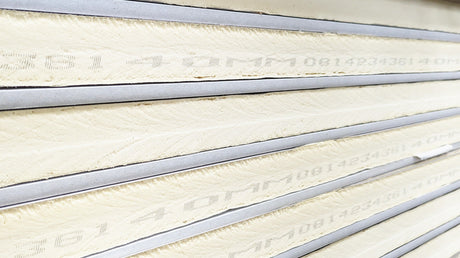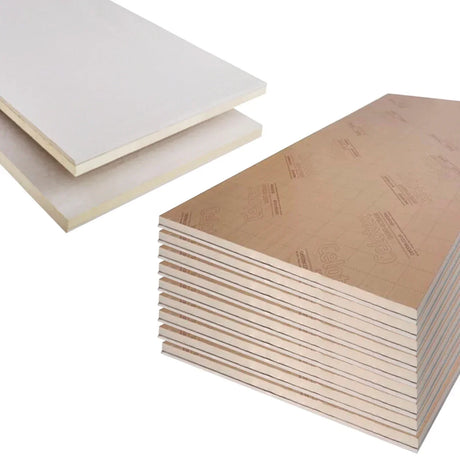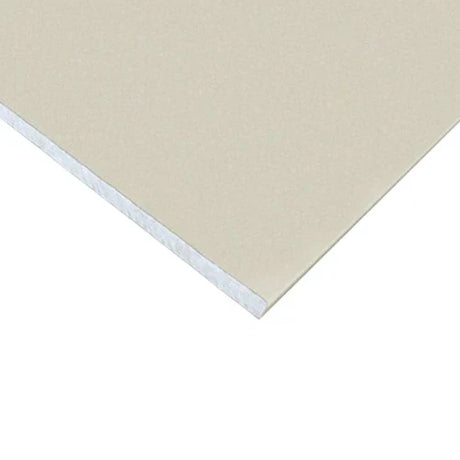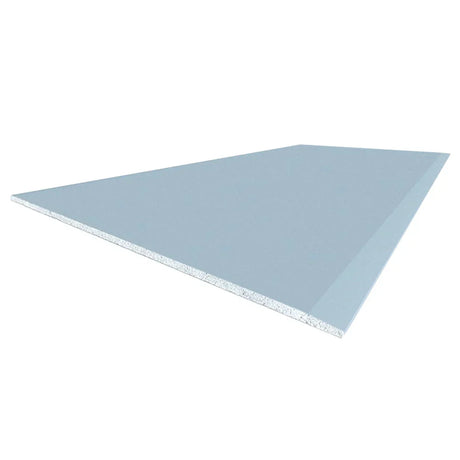The distinction between standard plasterboard and specialised fireboard extends well beyond simple terminology, encompassing fundamental differences in composition, performance characteristics, and appropriate applications. Understanding these differences ensures correct specification for buildings requiring enhanced fire protection.
Material Composition Differences
The fundamental differences begin with the core material composition and manufacturing processes:
Standard Plasterboard Construction: Conventional plasterboard consists of:
- Gypsum core (calcium sulphate dihydrate) with minimal additives
- Paper facings on both sides providing tensile strength and surface finish
- Typically manufactured to density of 600-700 kg/m³
- Primary design focus on cost-effective wall and ceiling lining
- Limited embedded reinforcement, if any
While standard plasterboard provides some inherent fire resistance due to gypsum's natural properties, its composition prioritises general purpose application rather than specialised fire performance.
Standard Fire Resistant Plasterboard: Fire-rated variants of conventional plasterboard feature:
- Modified gypsum core with increased density (typically 800-900 kg/m³)
- Glass fibre reinforcement distributed through the core material
- Standard paper facings, sometimes with modified formulations
- Pink or red identification colouring for easy recognition
- Manufactured using similar processes to standard board with modified formulations
Products like British Gypsum's Gyproc FireLine or Knauf's Fire Panel represent this category, delivering enhanced performance while maintaining compatibility with standard installation techniques.
Specialised Fireboard Construction: True fireboards represent a distinct product category with substantially different construction:
- Glass-reinforced gypsum core with significantly higher density (typically 1000-1200 kg/m³)
- Non-combustible glass fibre mat facings replacing paper liners
- Sophisticated core additives enhancing cohesion during fire exposure
- Higher percentage of reinforcing fibres throughout the material (typically 5-7%)
- Often manufactured using different production processes optimised for fire performance
Products like British Gypsum's Glasroc F, Knauf's Fireboard, or Promat's MASTERBOARD exemplify this category, offering superior performance in critical fire protection applications.
Composition Impact on Performance: These material differences directly influence behaviour during fire exposure:
- Standard plasterboard provides limited protection before paper facings ignite and the core loses structural integrity
- Fire-resistant plasterboard maintains integrity significantly longer due to core reinforcement, despite eventual paper facing combustion
- Specialised fireboard eliminates combustible components entirely, maintaining structural integrity for extended periods even under severe fire conditions
These performance distinctions make specialised fireboard the appropriate choice for critical applications where maximum fire resistance is essential.
Performance Characteristics Comparison
The material differences translate into substantial performance variations across key fire protection parameters:
Reaction to Fire Classification: Under the Euroclass system (BS EN 13501-1):
- Standard plasterboard typically achieves B-s1,d0 classification (limited contribution to fire)
- Fire-resistant plasterboard generally achieves A2-s1,d0 (very limited contribution to fire)
- Specialised fireboards achieve A1 classification (non-combustible)
This classification difference significantly impacts where each product can be appropriately specified, particularly in high-risk areas or escape routes.
Fire Resistance Duration: In standardised fire testing (BS 476 Part 22 or BS EN 1364-1):
- Standard 12.5mm plasterboard typically provides 15-20 minutes fire resistance
- Equivalent thickness fire-resistant plasterboard delivers approximately 30 minutes
- Specialised fireboard of similar thickness can achieve 60 minutes or more in appropriate systems
For multi-layer systems, these differences become even more pronounced, with specialised fireboard systems capable of achieving up to 180 minutes protection in tested configurations.
Structural Performance Under Fire Conditions: How the materials maintain their protective function during fire exposure varies significantly:
- Standard plasterboard rapidly loses structural integrity once paper facings are consumed
- Fire-resistant plasterboard maintains cohesion longer due to glass fibre reinforcement, but eventually degrades
- Specialised fireboard maintains structural integrity even after complete calcination, with non-combustible facings continuing to hold the core material in place
This structural integrity difference proves critical in applications like structural steel protection, where maintaining position throughout the fire event is essential.
Moisture Resistance Correlation: An important secondary consideration relates to moisture performance:
- Standard fire-resistant plasterboard often has limited moisture resistance
- Specialised fireboards frequently offer excellent moisture resistance as a secondary benefit
- This makes specialised boards particularly valuable in areas with both fire risk and moisture exposure
For applications like semi-external areas, pool surrounds with fire separation requirements, or commercial kitchens, this dual performance characteristic provides significant advantages.
Application and Installation Differences
The practical differences extend to installation methods, fixing requirements, and finishing techniques:
Cutting and Handling Characteristics: Working with different board types requires adjusted techniques:
- Standard fire-resistant plasterboard cuts and installs similarly to conventional board, using score-and-snap techniques
- Specialised fireboard typically requires power tools for cutting due to higher density and glass reinforcement
- The increased weight of fireboard (approximately 30-50% heavier than standard fire-resistant board) affects handling procedures and may require additional labour for ceiling installations
These practical differences impact labour requirements, tool provisions, and installation programming.
Fixing Methods and Requirements: Securing the different materials requires adjusted approaches:
- Standard fire-resistant plasterboard uses conventional drywall screws at standard centres
- Specialised fireboards often require specific screw types with enhanced corrosion resistance
- Fixing centres are typically reduced for fireboards (200mm vs 300mm for standard boards)
- Edge distance requirements may differ, with fireboards often requiring fixings closer to board edges
These variations must be reflected in installation specifications to maintain the expected performance characteristics.
Jointing and Finishing Techniques: Surface finishing approaches also differ:
- Standard fire-resistant plasterboard accepts conventional jointing and finishing techniques
- Specialised fireboards may require specific joint compounds compatible with their surface characteristics
- Some fireboards are designed for functional rather than decorative applications and may not provide the same surface finish quality
- Fire-stopping details at junctions and penetrations differ significantly between systems
These finishing variations affect both aesthetic outcomes and the integrity of the fire protection system.
Cost and Value Considerations
The different product categories occupy distinct price points reflecting their performance capabilities:
Cost Structure Comparison: Typical relative cost positioning:
- Standard plasterboard represents the baseline cost benchmark
- Fire-resistant plasterboard commands approximately 20-40% premium over standard board
- Specialised fireboards typically cost 3-5 times more than standard plasterboard
These cost differences make appropriate specification particularly important, avoiding both under-specification that compromises safety and over-specification that wastes resources.
Value Engineering Implications: Understanding performance differences enables appropriate value engineering:
- For non-critical applications requiring basic fire resistance, standard fire-resistant plasterboard often provides the most cost-effective solution
- For critical applications where failure consequences are severe, specialised fireboard typically represents better value despite higher initial cost
- Hybrid systems using different board types in appropriate locations can optimise both performance and cost
This nuanced understanding helps achieve appropriate protection while managing project costs effectively.
Lifecycle Considerations: The long-term value equation extends beyond initial costs:
- Specialised fireboards often offer enhanced durability and impact resistance as secondary benefits
- Their superior moisture resistance may reduce maintenance requirements in certain applications
- The assurance of maximum protection may reduce insurance premiums or provide other financial benefits over the building lifecycle
These factors should be considered in lifecycle cost assessments rather than focusing solely on initial installation costs.
By understanding the substantial differences between conventional fire-resistant plasterboard and specialised fireboard products, building professionals can make informed specification decisions that appropriately balance performance requirements, practical installation considerations, and project economics.









